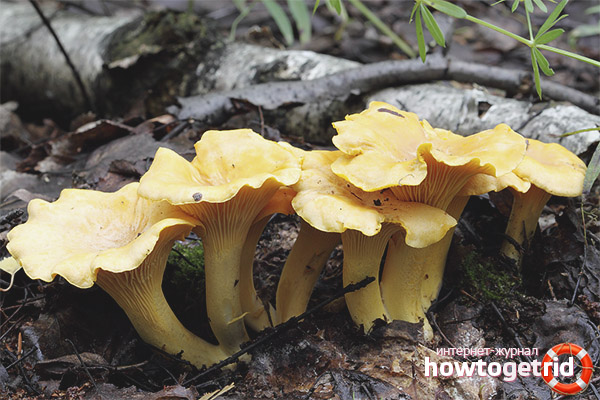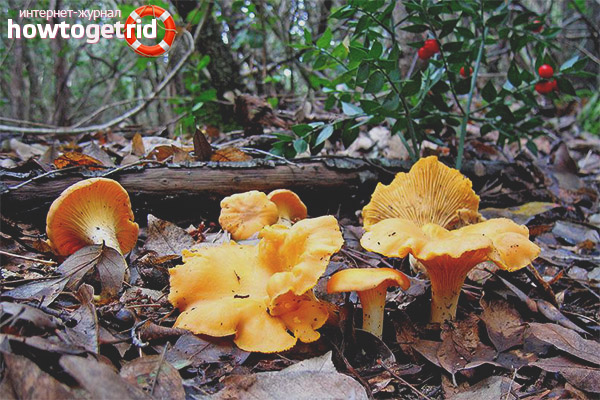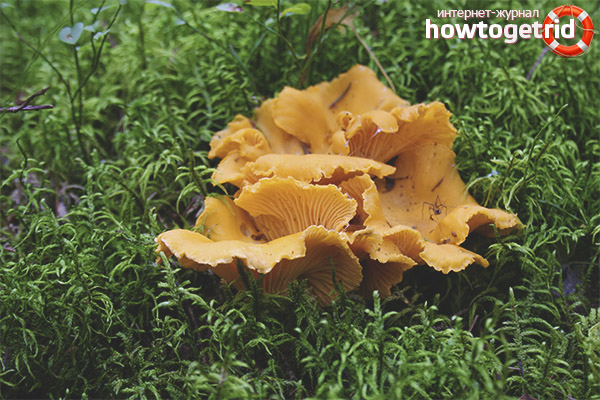The content of the article
Today we will study reddish-colored mushrooms, which are called nothing more than chanterelles. They are famous for the large inclusion of ascorbic acid in the composition, therefore they are extremely beneficial for human health. In nature, several varieties of this variety are distinguished, which include chanterelles edible and not suitable for ingestion. As for growth, this species prefers to live on the decayed bark of trees in a mixed or coniferous strip.
Description
- In their format, chanterelles are similar to other mushrooms that have a hat with a leg. But the representatives of the species under discussion are a single whole, there are no visible transitions from the top to the base. The same goes for color, there are no strong demarcations in the shade. The shade of chanterelles varies from orange to dull red.
- The hat in diameter reaches 10 cm or more. The shape is irregular, half-flat. The edges are bent inward, they are wavy in structure. In old mushrooms, the hat may bend outward or be slightly depressed. In common people, this form of the upper part is called an inverted umbrella. The skin on the surface is poorly separated, it is smooth and dense.
- The soft part is compacted and fleshy. The leg consists of fibers, the color of the flesh is yellow or whitish. The soft part is sour to taste, it smells like dried fruits. If you press the mushroom, then the pressure zone will become reddish.
- As a rule, the leg is light in shade, the hat is slightly darker. The base narrows in the lower part, it is about 2 cm in diameter and 6–7 cm long. The hymenophore is quite plastic, wrinkled, fibrous, and falls down the base. Spores are yellow in powder form.
Varieties of chanterelles
To date, about 60 varieties of this variety of mushrooms are isolated. Some of them can be eaten, others cannot. There are no poisonous specimens, but it may be a fox. There are also poisonous counterparts belonging to the genus omphaloths. Now we will study the most popular types of the discussed family.
- Common. Otherwise, this species is called a cockerel or a real fox. It is allowed to eat. As for the sizes, the hat grows up to 10-12 cm in diameter. The stalk is approximately 2 cm in thickness and 6 cm in length. The spores are in the form of a yellowish powder. The color of the fungus varies from orange to yellow. The soft part is fleshy and compacted, when cut becomes white. The taste of fox sour with the smell of dried fruits. The skin on the hat is difficult to separate, it is dense and smooth. The base is the same color as the hat. A positive feature of this variety of mushrooms is the fact that it has hinomannose. The substance does not allow fungi to become worms. Insects cannot set aside larvae because they do not take root. By growth, chanterelles prefer coniferous and mixed stripes. The collection is carried out from the end of summer to the middle of autumn.
- Velvety. Another edible variety with a yellow-orange surface with a red tint (not always). As for the shade of the base, it ranges from light red to pale yellow. The hat grows up to 5 cm in diameter and the leg is about 4 cm long with a thickness of 1 cm. In young animals, the surface is convex, but as it grows, the hat bends in the opposite direction in the shape of a funnel. The soft part on the cut becomes light, orange or yellow. By the smell, the mushrooms smell pleasantly; to taste, they have sourness. This species grows in Europe in the south and east.Prefers to dwell in acidic soil. Gathering is best done from mid-summer to mid-autumn.
- Cinnabar red. Mushroom in shade red with pink or dull red. The apex in diameter varies within 2-4 cm., The leg in height is 3-4 cm. The soft part is densified, fibrous. The hat is uneven at the edges, the side parts are tucked down, while the surface itself bends inward. Spore surface with folds, plates pinkish and thick. The spore powder is pigmented with a creamy pink color. These chanterelles live in an oak grove, larch trees. They can be found in North America during the summer and fall.
- Gray. The mushroom is suitable for ingestion, has a black tint with brown spots. May be pure gray. The hat is about 2-5 cm in diameter, the leg grows up to 5-8 cm in height and 1 cm thick. The inside of the base is not full. The hat is pigmented at the edges in gray with an ash tint, its edges are bent inward. The upper part has a recess located in the center. The pulp is pigmented with brown or gray, it is quite fleshy and elastic. By taste, these mushrooms are not as expressive as the predecessors described above. There is no aroma. Gray representatives of the species prefer to grow in a mixed or deciduous zone. You can deal with collection, starting from the third month of summer, ending with mid-autumn. The mushroom grows everywhere, but not all mushroom pickers are aware of it.
- Yellowing. Another subspecies of the edible type, whose hat is about 5 cm in diameter. The leg varies in length from 2 to 5 cm with a thickness of 1.5 cm maximum. There is no distinction between the top and the base, the mushroom looks holistic. The hat is pigmented with a brownish-yellow hue, there are scaly elements on it. The base of the shade of orange with yellow. The soft part is dense, tasteless, no aroma. The pulp has a light red or beige hue. Spores in the form of a powdery composition are pigmented in an orange-beige tone. These chanterelles love to grow in forests with conifers, they like a humidified environment. The collection can last a couple of months, starting in August.
- Faceted. The mushroom is suitable for eating, stained yellow-red. The fruit itself grows up to 10 cm in size. The leg with a hat is one, there is no clear distinction. Hat shaped cut with the edges of a wavy structure. Mushroom flesh is compacted and thick, saturated to taste and smell. Leg in diameter is about 2 cm. Spore surface with small folds. Disputes on the shade of red and yellow, similar to the color of the mushroom. These chanterelles grow in African countries, North America and Malaysia. Settled in colonies or singly. You can collect from late summer to autumn.
Growth
- As for the classical form of the fruits in question, they grow preferably in coniferous and mixed forests. Instances can often be found among moss and tall plants. Often, mushroom pickers go to pick fruit from July to late fall.
- In order for the crop to be excellent, such fruits need a lot of nutrients and moisture. All the necessary components penetrate the chanterelles through moss and wood. As for deciduous forests, under such conditions, chanterelles are uncomfortable.
- The problem is that when the leaves fall from the trees, the specimens in question do not receive the proper amount of sunlight. If the chanterelles do not receive everything they need, they deteriorate and dry out.
- The favorable habitat for such mushrooms is precisely mixed and coniferous stripes. In the soil in which spruce and pine grow, there is an abundance of substances that are necessary for the fruits. In this area, chanterelles can bear fruit more than once per season.
Mushroom appearance time
- Often, specimens appear from July to mid-autumn. Most fruits come out in late summer after warm rains. Such fruits do not tolerate cold weather, it is for this reason that they do not occur in winter.
- It is worth noting that the chanterelles also do not tolerate the scorching sun, as well as frosts. For the same reason, you can see that in June the fruits grow noticeably slower. After the summer rains, several days must pass before the chanterelles begin to grow fully.
Edibility
- It is worth noting that there are species of chanterelles that are suitable and unfit for food. The classic mushroom has a delicate shade and smells good. As for the false fruits, the unpleasant aroma of vinegar or fish comes from them.
- In addition, edible and inedible specimens can be identified by some differences. In false mushrooms, the color of the hat has a brighter orange color. As for edible specimens, their color is yellow.
- Inedible fruits also have a clear circle shape on the hat. An edible mushroom has a thick leg, while a false one has a thin one. A vinegar aroma also produces inedible fruits. Do not forget that real foxes grow exclusively in coniferous and mixed forests.
- As for the pulp, it is yellow in edible specimens, and has a white color towards the center. In false chanterelles, it is completely orange. In addition, real fruits can be cooked, fried and baked without any problems. Classic chanterelles make delicious dishes.
The difference between false mushrooms and chanterelles
Classic chanterelles can be confused with two types of mushrooms. Most often, this happens to be an orange talker (inedible fruit) and an olive olmphaloth (poisonous fruit).
- The common chanterelle has a plain color. It can be light orange or light yellow. Inedible fruits opposite will have bright colors or opposite too light. Also, false mushrooms on the hat often have spots of various shapes.
- An interesting difference is that edible chanterelles always have ragged edges on the hat. In false fruits, they are often even. In addition, the classic instances have a thick leg. Inedible fruits, it is always thin.
- The common chanterelle has integrity. Her leg smoothly flows into the hat. False mushrooms stand out because the hat is separated from the legs. In addition, the fruits that you can eat always grow in groups. False specimens often grow alone.
- As mentioned earlier, ordinary chanterelles have a rather pleasant smell. They are never wormy. When pressed on an edible mushroom, the flesh begins to redden. Similar facts cannot be said about the false fruits.
Benefit
- Real foxes are famous for their abundance of minerals, vitamins and various enzymes. As mentioned earlier, the specimens in question are almost never wormy. This can be explained by the fact that the composition of the considered fruit bodies contains quinomannoses.
- Such a substance is a poison for all kinds of arthropods and helminths. The enzyme mentioned earlier envelops the eggs of parasites, after which it destroys them. In addition, ordinary chanterelles are considered an excellent natural remedy in the fight against parasites and worms.
- In addition, edible fruits have a sufficient amount of ergosterol. Such an enzyme is useful in pathologies that are associated with the liver. Chanterelles are very useful for hemanginoma and hepatitis. Systematic eating of such mushrooms helps restore vision and fight oncological pathologies.
Storage
- When collecting a good harvest, you must definitely know how to properly store fruiting bodies. Common chanterelles are most often frozen, salted and dried. If you want to keep the composition as useful as possible, it is better to freeze the mushrooms.
- Keep in mind that if you decide to store the fruits at home until cooking, then the temperature should not be higher than 12 degrees. Untreated specimens can lie no more than a day. Therefore, decide how you will process them and proceed to the procedure.
In today's article, we have studied everything related to chanterelles. We examined the possible and common variations of the species, as well as their growth in the natural environment and periods when you can engage in gathering. It is very important to be able to distinguish one variety from another in order to collect a basket of various fruiting bodies. Do not forget about the primary processing and the rules for the preparation of chanterelles.
Video: healing properties of chanterelles













Submit